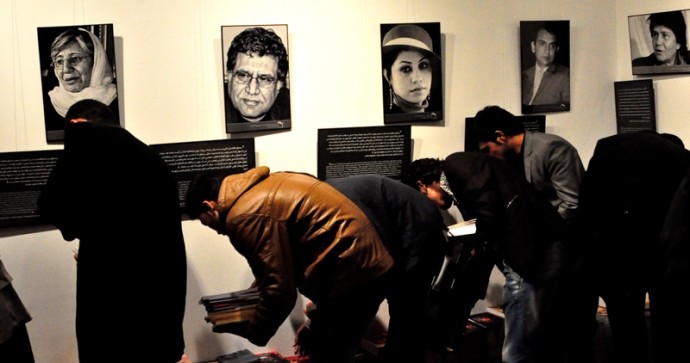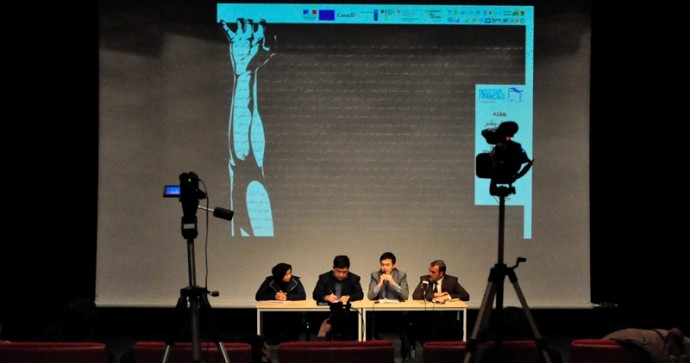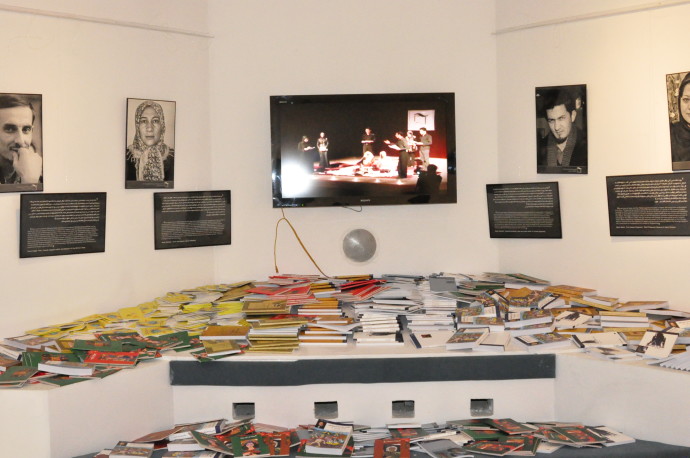Freedom of Speech and the influence of social e-networks.
Panel: Sanjar Sohail (Licence holder of 8 Sobh newspaper), Ms. Humira Sagheb (Editor in chief of Negah-Zan -Women’s vision – and founder of the first Women’s News Agency), Sami Mehdi (Winner of brave journalist 2012 Knight International Journalism Prize, director and editor in chief of Khorshed TV), Lotfullah Najafizada (Tolonews’ director of information), Aimal Sanjida (National TV News Director), Head of session:Sediqullah Tawhidi (President of Nai- Supporting Open Media in Afghanistan)
The Human Rights Week programmes, organised by Armanshahr Foundation and the French Institute in Afghanistan (FIA), opened with a roundtable discussion on “Freedom of speech and the impact of social networks”, an artistic exhibition with the title of “UNSAID”, and educational workshops for civil society and human rights activists in the FIA in Kabul on 7 December 2013. A large number of activists, writers, students and citizens took part.
The roundtable discussion “Freedom of speech and impact of social networks” was chaired by Sediqullah Tawhidi, director of Nai, examined the role of social networks in Afghanistan, role of the media in the past few years and the achievement of freedom of speech.
Number of women journalists has fallen by 10%
The first speaker, Ms Humira Sagheb, Editor-in-Chief of Negah-e Zan magazine, said: “With the collapse of the Taleban system and the emergence of the new system, a media explosion occurred under the auspices of a semi-democratic military central government and scores of audio, visual and print media were born. Women journalists, however, have been deprived of working as journalists in 18 provinces of the country. Journalism is a hard task and, in some cases, very dangerous work for women in some provinces. There are several reasons for the weak presence of women in the media: the patriarchal attitude and the society, and higher public sensitivity towards women who work outside home and in visual media in comparison with women who work in various departments. Women’s clothing, appropriate for their jobs, has prompted the tradition-centred attitudes to rise in opposition to them. Another problem facing women journalists is the limitation on their work. Women are deprived from job opportunities for gender-based reasons. One other significant issue that is hidden from many media critics concerns the unethical demands on women by some media people. Hence, a large number of women journalists have come under pressure and lost their jobs.”
Referring to Mr Tawhidi’s report on the conditions of women journalists, she said: “The number of women journalists has fallen by 10% in the past two years. Let’s not forget that we have lost more than 10 women journalists during the past decade. The catastrophe looks bigger when you notice that women do not create their own pages on social networks under their real names. If they do, they will face different kinds of harassment. Afghan journalists are facing a variety of problems and dangers, but women’s share of those dangers is much higher than men’s. In my opinion, there will be no change in the conditions of women so long as the gender equality issue does not become a social discourse. Empowering the women of Afghanistan and demanding equality for them is impossible without political, security, and job stability, access to lower and higher education, guarantees by such institutions as the Ministry of Women’s Affairs and Afghanistan Independent Human Rights Commission, and the increase in overall awareness of women.”

Subsequently, Mr Tawhidi underlined the key parts of Ms Sagheb’s presentation and asked Mr Shah-Hossein Mortazawi, editor of 8 Sobh daily, to discuss the emergence of information technology, social networks and freedom of speech.
Human Rights: a “minor” issue
Mr Mortazawi began with the need for the fundamentals of human rights in Afghanistan and argued: “The issue of human rights and freedom of speech has not become a dominant discourse in Afghanistan yet. Human rights are still considered a secondary and minor topic. One of the most fundamental achievements at the present time is the end of the government monopoly over the media. In the past, the governments controlled the media, they produced the news and published it. Under the new system, thanks to the social networks, every citizen has become a reporter. This means that every citizen is a very strong medium. However, the culture of proper usage of social networks has not been established among the people yet. We must try to use them properly and transmit positive messages to the society. As a professional working for a print medium, I want to bring to your attention a few points about our professional responsibility towards freedom of speech and human rights. The media play a distinctive role in identifying, transmitting and developing the human rights issues. You surely remember the bloody events in Rwanda. One radio station caused two ethnic groups to fight each other by publishing negative messages about the behaviour of a specific ethnic group. In a period of 100 days, nearly 800,000 people were killed. It all originated from numerous radio messages. Therefore, the media can represent both good as well as evil.”
“Unfortunately, as you well know, there is no historical memory in Afghanistan. It is noticeable that the warlords who played a role in Afghanistan’s insecurity and directed human catastrophes are still at the top of the political power pyramid as presidential candidates and a large number of people heed their call. This shows the weakness of our collective and historical memory. In my opinion, the media can enhance the collective memory of the people by publishing documentaries, films and stories about the past to enable the people to make better choices and know the politicians at the summit of power. In 8 Sobh daily, we collected and published about 1,000 stories and memories by the victims of the wars of the recent decades. The narratives of these victims on the war and bloodshed can be used as sources for the media to produce documentaries. The other action that the media can take is to report and highlight the examples of other countries that succeeded in transitional justice. For example, Afghanistan can make optimal use of the model of South Africa. As you may well know, there are a large number of survivors of the war. By establishing institutions to console the victims and covering such actions in the media, we can take long steps towards national reconciliation. This will reduce the sentiments of retaliation in the country. The other thing that was done in South Africa and we can also use in our country was the promotion of the culture of apology. You know well that a large number of our leaders who were instrumental in the war and homelessness of the people of Afghanistan are not prepared to apologise to the nation. Apologies by the perpetrators and the guilty would reduce the victims’ desire for retaliation.”
The chair of the meeting commented: “What Mr Mortazawi said about the media applies to the social networks as well. It is much easier to broadcast documentaries and films through the social networks. However, nothing has been done fundamentally in this respect for various reasons.”
Unprecedented media achievements
The Chair asked Mr Lotfullah Najafizada, Tolonews’ director of information, to discuss the impact of social networks and other media such as television on production of independent news.
Najafizada said: “I have a positive interpretation of the past decade and the conditions of the media under the new system in particular. In my opinion, we have had unprecedented achievements in regard to freedom of speech and freedom of the media. Those achievements have highly influenced the society. It is my belief that the people’s wish has kept the media alive and thriving. The activities of the media are now a two-way street. The information is not disseminated in one direction only, as was the case in the past. Our media are producing and disseminating about 200 hours of news programmes and talk shows every 24 hours. Internet users in Afghanistan spend half of their time in social networks such as Facebook and Twitter. We try to establish a closer relationship with the people through the social networks and find out what is important for them, which news interests them and which ones they like. That was not the case even five years ago. The people’s role in the production of the media today indicates that they have a loud voice in producing the media discourse. We have about 500,000 Facebook users in Afghanistan. If you examine the campaigns of presidential candidates, you will clearly notice that some of their programmes are directed at the social media.
“The other point that I want to raise concerns freedom. Our freedom today is unprecedented. Nobody can tell other people not to say something unless our public and national security is endangered. Just compare that with the past. Our forefathers never enjoyed such freedom. They could not even speak freely in their homes for the fear that a family member may have been in contact with the government. Today, we witness many positive changes in our society even in respect of women’s participation. In the medium where I’m working, my most successful colleagues are women. They are our real heroes in the field of obtaining information and establishing contact with the people. I do accept that there are challenges; I do accept that we are moving along a difficult path. However, we have taken very long and powerful steps in the past 10 years. In my opinion, we will witness a series of qualitative reforms in the media in next 10 years. Many media were born in the past 10 years with the help of the money that flew to the country and the project-based approach to the media activists. The coming years, however, will be different from the past. A number of the media may leave the scene. However, the media will be in a better position qualitatively, because the market will shrink and the media will have to offer attractive and creative programmes to survive. Therefore, I believe that our media will be in much more different and better conditions in the next 10 years.”
Questions and answers
In the question and answer section of the programme that followed, Mr Tawhidi questioned Mr Najafizada about the increased participation of women in the media with a view to Ms Sagheb’s remarks. Mr Najafizada said: “This participation partially relates to the institution of the family and women’s role in it. Family can act as both an instrument of pressure and obstacle to women’s wishes or as a factor for the growth of women. The constraints that the institution of the family place on their daughters take precedent over all the external and social restrictions and are more dangerous. The fall in the participation of women is not without relation to 2014 and the withdrawal of the NATO’s military forces from Afghanistan. In the absence of a clear perspective of the future, not only women but men have also lost their jobs.”
Mr Tawhidi asked Ms Sagheb: Why do men, in some cases, and women in many cases keep silent in the face of social pressures?
Ms Sagheb replied: “Mr Najafizada spoke about 2014 and the general fear of the vague future. I fully agree with him, but the point is that they expel women first of all in various departments. Women are the first and foremost victims in the situation of crisis of confidence and unemployment. We have tried to examine the women’s problems in respect of ways of dealing with social pressures. One side of the issue is to raise the awareness of women and find better ways of informing them. We tried to rescue them from self-censorship and seclusion.”
The chair asked Mr Mortazawi to discuss the role and function of social networks in respect of disseminating information and social change.
Mr Mortazawi said: “I think the culture of using the social media is growing. Most messages that the people of Afghanistan publish in the social media are tinged with humanitarianism and that is not a small achievement. At present, the topics of social justice, elections and women are the hottest issues in the social media. This indicates that the type and mode of using the social media is changing.”
In the free discussion part of the meeting, Basharmal Fatehi, a writer and jurist, asked Ms Sagheb: “you spoke about unethical attitudes towards women in various departments. I wish to know what solution you have for this problem.”
Ms Sagheb replied: “I’m very happy that the women’s issue is being discussed after 10-12 years. Women are heard and listened to. I believe a society will advance where the women are advanced. In my opinion, the problems of women in Afghanistan should be resolved through academic ways not by superficial and temporary measures.”
Another participant, Ms Amena Amen, questioned Mr Najafizada about the role and participation of women in his organisation. Mr Najafizada replied: “Our attitude to our women colleagues is not an exceptional one. We tried to recognise their identity, to respect them and have understanding for their conditions.”
The roundtable discussion ended at 4 pm and the artistic exhibition “UNSAID”, managed by Mr Kabir Mokamal and Armanshahr House in the French Institute, was inaugurated at the presence of the senior officials of the French and Swiss embassies in Afghanistan. The exhibition is the collective work of three women artists, most of whose works concern women and war.
During the Human Rights Week (7-11 December 2013), Armanshahr House receives viewers of the photo exhibition “Unveiling Afghanistan“, which is an exhibition of pictures and views of 20 dignitaries on important issues concerning human rights. Furthermore, 5,000 copies of the books published by Armanshahr Foundation will be distributed to the visitors for free and short documentaries, feature films and plays will be screened throughout the days.



